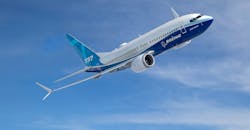FAA Adds to 737 MAX Repair Requirements
The Federal Aviation Administration is proposing a new correction to the Boeing 737 MAX aircraft, adding a new delay in the process of returning the twin-engine jets to commercial service. In a Dept. of Transportation posting, the FAA outlined a new "airworthiness directive" (AD) for the 737 MAX-8 and 737 MAX-9 jets, in response to reports that exterior panels on the engine nacelles and struts "may not have the quality of electrical bonding necessary to ensure adequate shielding of the underlying wiring from the electromagnetic effects of lightning strikes or high intensity radiated fields". Such an event could trigger a "a dual-engine power loss event," according to the FAA posting.
Boeing alerted airlines to the potential problem with the panels in a December maintenance bulletin, explaining the process of inspecting the aircraft to determine the need for repair or replacement, and detailing the repair/replacement for panels. It advised that the jet owners had six months to complete the inspections and repairs.
The FAA bulletin proposes that these repairs be completed before the 737 MAX is cleared to resume commercial service.
The schedule for returning the aircraft to service remains uncertain as a result of various inspection and repair issues — mainly the authorization of the new flight-control software that will replace the program cited as the cause of two fatal crashes of 737 MAX jets, in October 2018 and March 2019. The aircraft was idled by airlines and safety agencies worldwide, and Boeing halted deliveries of new 737 MAX jets last March.
Major 737 MAX operators, including American Airlines, Southwest Airlines, and United Airlines, have removed the aircraft from their schedules through mid 2020, though it remains unknown if jets will be authorized for service then.
The new flight-control software has yet to be accredited by FAA or other air safety agencies, and other airworthiness issues have been raised in the meantime.
